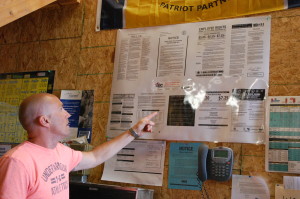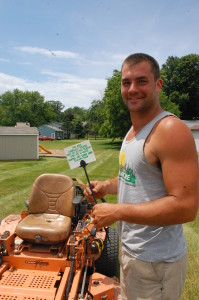By Melissa Walker
A company’s employees can be its most valuable and riskiest asset. Business owners are required by law to provide a safe work environment for their employees and to give them the necessary training required by the Occupational Safety and Health Administration (OSHA), a subset of the U.S. Department of Labor responsible for assuring safe and healthy working conditions by setting and enforcing standards and providing resources, training and other assistance.
Safety on the worksite should be a top priority for business owners, big and small, says Jens Nissen, OSHA administrator for the state of Iowa. However, it’s something smaller businesses struggle with and are more likely to have violations of as a result.
“It’s hard for the small employers to deal with the safety and health in the workforce because they don’t have a specific person designated to this,” he says. “They’re focused on getting the job done and being successful in that regard, but I would say not to separate safety from that aspect of their business. One is a big part of the other and inextricably bound.”
There are things small business owners can do to ensure they are providing a safe workplace and protecting themselves in case of an employee injury and a resulting workers’ compensation claim.
1. Know obligations, requirements under law
The Department of Labor details the requirements of a safe workplace on its website (www.dol.gov). These include:
Providing a workplace free from serious recognized hazards that complies with OSHA standards, rules and regulations.
Ensuring employees have, and use, safe tools and equipment that is properly maintained.
Using color codes, posters, labels and/or signs to warn employees of potential hazards.
Providing safety training in a language and with a vocabulary workers can understand, as well as medical examinations as required.
Creating hazardous chemical plans and providing copies to employees.
Reporting to the nearest OSHA office within a designated time period all work-related fatalities, inpatient hospitalizations, amputations and losses of an eye.
Keeping records of work-related injuries and illnesses.
Correcting cited violations by the deadline set in the OSHA citation and submitting verification of correction.
There is more information available on the OSHA website: www.osha.gov.
Every business owner regardless of the number of employees needs to know and understand OSHA guidelines because most are subject to all aspects of the rules, Nissen says.
The state’s OSHA department has 21 inspectors who are continuously monitoring job sites to ensure worker safety.
Requirements can differ for the industry in which one works, which is why Nissen says business owners should review the federal and state OSHA standards in their entirety.
For example, machinery should be guarded in a way that a passerby cannot be harmed. If an employee is working on an elevated surface, the company needs to ensure that person has fall protection. Plumbers or other workers doing excavation work need to have a protective structure set up in case of a cave-in.
Trevor Simpson, owner of Capital City Lawn Care in West Des Moines, follows regulations when it comes to use of pesticides and other chemicals for his lawn care business. He keeps spray log books and records wind speed, temperature and the time in which a particular chemical was sprayed. Lawns and areas that are treated must be flagged to warn passersby of the use of pesticides or other chemicals.
“There’s all kinds of rules to keep everybody safe,” he says.
The managers of Cook Plumbing Corp. in West Des Moines ensure their 120 plumbers go above and beyond to keep themselves safe at work. The company requires employees to keep job sites clean by sweeping and cleaning up debris at the end of the each work day. If the employee is working in a multi-unit building, he must clean up his worksite before moving on to another one.
Scott Smith, the company’s general manager, says this keeps employees more aware of their surroundings and the site clear of potential tripping hazards or other dangers.
At Webster Electric in Waukee, OSHA health and safety regulations are posted, and the company’s 42 electricians — both apprentices and journeymen — receive all OSHA-required training. In addition, the company keeps safety manuals in the office, which detail the company’s safety policy and a list of hazardous materials.
Mike Webster of Webster Electric points out OSHA safety regulations that are located onsite at the company in Waukee.
2. Seek outside help to ensure hazards are mitigated
A second set of eyes from an expert can be a good thing when ensuring a worksite is safe and free of hazards for employees.
Nissen says anyone with questions regarding OSHA regulations can contact his office or the separate Iowa OSHA Consultation and Education bureau.
Business owners who have fewer than 250 employees on site or 500 company-wide are eligible for Iowa OSHA’s on-site consultation services, which help employers identify safety and health hazards in the workplace.
These services are free, confidential and separate from Iowa OSHA enforcement. The consultation will point out hazards; provide a review of written safety and health programs, and injury and illness recordkeeping; provide industrial hygiene services such as monitoring exposures to fumes, dusts, chemicals and noise; and evaluate engineering controls.
The employer will not receive a citation or penalty for any safety and health hazards discovered but agrees to correct the issue within a set timeframe, says Joe Mullen, Bureau Chief for Iowa OSHA Consultation and Education.
That’s what happened for Webster Electric. Mike Webster, one of the company’s owners, says OHSA officials have been helpful in identifying any hazards on the job site and giving the company time to correct them. Every five years, Webster goes through an audit by the Department of Labor to examine the company’s hiring practices and its standards for apprentices.
During the consultation, an OSHA consultant also will explain the rights and responsibilities the employer has for hazard identification and other OSHA regulations. Then they will conduct a walk-through of the workplace to identify hazards that may also be violations standards. If any serious hazards are found, there will be a closing conference in which the hazards are discussed with an agreed amount of time for correction.

“We’re trying to evaluate their health and safety management programs, which is a system that assists companies in identifying and correcting hazards through hazard recognition and correction, accountability, responsibilities and training,” Mullen says.
Free consultation services are available once a year or every two years. Mullen says the service is one that small business employers should take advantage of to ensure they have appropriate health and safety plans in place.
Iowa OSHA’s Consultation and Education office also provides hazard awareness training for small businesses and has a video loan library that contains videos on various health and safety topics that businesses can borrow for free to provide additional information to their employees.
Nissen also suggests businesses contact their insurance carrier or trade association for additional resources.
Cook Plumbing works with its insurance company to have an agent come to job sites and perform a walk-through to determine if there are any hazards the company can eliminate or ways it can improve the job site.
Simpson sought help through the Iowa State Extension Office when he started his lawn care business six years ago.
“They told me everything I need to do, and they gave me a study booklet,” he explains.
Simpson was required to learn about the various chemicals he would be using, what type of protective equipment — gloves or a respirator — he would be required to wear and how to keep others safe once chemicals have been used. He had to pass a written test and takes a recertification course or test-out option each year.
3. Ensure employees receive training to keep themselves safe
All electricians at Webster Electric are required to take continuous OSHA safety training during their four years of apprenticeship school. The company’s journeymen electricians take 18 hours of continuing education every three years in order to keep their electrical license. Six hours of this training are about the electrical code, and 12 hours are safety driven on topics such as general electrical safety and arc flash training. The company’s underground division receives its own separate training about welding and other topics related to their jobs.

In addition, the company provides employees with CPR and first aid training and conducts some in-house training about various topics.
“We try to keep up and continue to provide that training,” Mike Webster says.
At some job sites, there may be weekly safety meetings with general contractors to inform all workers of potential hazards on the site. Workers including electricians, plumbers and other trades may be required to wear high visibility vests and hard hats to ensure safety.
Other companies host in-house trainings. Representatives from Associated Builders and Contractors Inc. recently went to Cook Plumbing at the company’s request to conduct a training session on heat exhaustion and how to keep cool, as well as ladder safety and other general safety issues.
Company officials also reviewed employees’ equipment and tools, which is done about once a year, to ensure they’re in good working order and meet OSHA standards.
Every two years, Cook Plumbing employees are recertified to use backhoes and other small equipment, even though the requirement is once every three years.
Smith says the company videotaped the training session with ABC and will use it to create an orientation video for new hires.
Trevor Simpson, owner of Capital City Lawn Care in West Des Moines, is required to post this flag anywhere where he sprays pesticides and other chemicals for his lawn care business.
4. Protect interests with insurance, knowing signs of fraud
According to the Labor Department, an effective safety and health program can save a business $4 to $6 for every $1 invested because paying for an accident or injury through a workers’ compensation claim or sick days can be more expensive than taking safety measures.
Business owners can also protect their companies and employees by carrying workers’ compensation insurance. This insurance will cover an employee’s wages and medical-related expenses — rules can vary by state — in cases of on-the-job injury or illness.
In Iowa, the Workers’ Compensation Act is part of the Iowa Code and allows for certain benefits to be provided to employees who are injured or receive occupational disease or hearing loss during, or as a result of, their employment. The benefits are payable regardless of fault.

Employers need to be mindful that cases of worker’s compensation fraud do exist, according to EMPLOYERS, a group of companies that provides workers’ compensation insurance and services to small businesses.
Business owners need to take the following into consideration when a claim is file, according to the group:
Was the injury or illness reported in a timely manner?
Does the employee have a history of claims?
Were there witnesses to the incident?
Does the incident coincide with any change in employment status?
When was the injury reported — first thing on a Monday or late on Friday? Waiting until Monday can be seen as questionable.
Does the employee’s description of what happened conflict with the medical history or injury report?
Did the employee refuse treatment?
Workers’ compensation insurance costs can be minimized by making safety a priority and discussing it regularly with employees, according to Entrepreneur magazine. This includes sharing injury information with workers and explaining the cost to the company as a result.
Business owners and managers also should examine any trends in workplace injuries to address the causes and utilize workers’ compensation safety programs whether through a government office or online resources, according to Entrepreneur.
“We’re trying to evaluate their health and safety management programs, which is a system that assists companies in identifying and correcting hazards through hazard recognition and correction, accountability, responsibilities and training,” Joe Mullen, bureau chief for Iowa OSHA Consultation and Education.
5. Make a health and safety plan; take immediate action if an injury or violation occurs

OSHA officials say businesses should put health and safety plans and policies in writing. Larger companies may have a designated person on the payroll who handles these types of issues.
Even if the company does not have a point person, the manager or owner still needs to take immediate action if an employee is injured on the job site.
Webster says there are a high number of worker’s compensation claims in the electrical industry as a whole because of the nature of the work, however his company has not had any severe injuries in the 31 years of its existence. He credits this to promotion of safety and common sense and encouraging employees to pay attention to their surroundings and providing them with necessary training.
“We want everyone to go home to their families,” he says.
The company has a safety plan and keeps safety records of any incidences that may occur such as a twisted ankle or cut. Webster has had one OSHA citation in the company’s 31 years, for a temporary power violation caused by a broken outlet or a GFI (ground fault interrupter) that wouldn’t trip when the company was responsible for providing power to an entire job site, Mike Webster says.
Supervisors at Cook Plumbing send each employee who is injured on the job site to a walk-in clinic even if the injury doesn’t seem serious, Smith says. Some common injury issues in the plumbing field include twisted ankles from stepping in a hole at the job site or falling off of a ladder; glue, primer or chemicals in contact with the skin or eyes; or the risk of shock from frayed electrical cords.
Cook Plumbing is moving toward having a person on site who is designated to handle health and safety issues. Currently, the company’s warehouse employee keeps track of tools and ordering new ones for employees when needed. Individual employees are responsible for ensuring their tools are in good working condition and meet OSHA standards, Smith says. Any tools that are not are turned in to the company are thrown out, and the employee receives new ones, he continues.
Many times things simply come down to common sense when it comes to safety on the job site.
“If something doesn’t look right, it probably isn’t,” Nissen says. “You don’t want to overcomplicate things.”


Leave a Reply